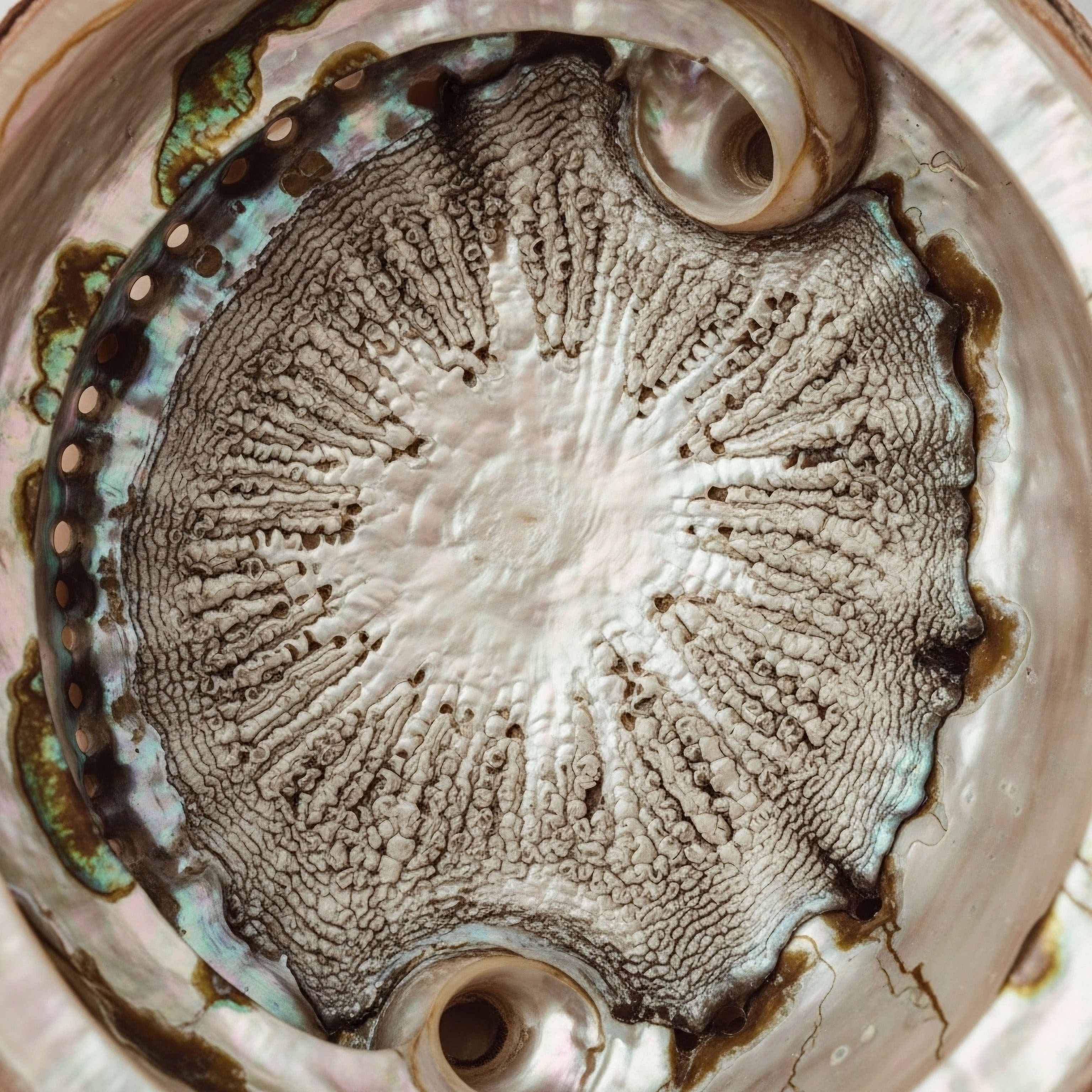

Fundamentals
You may be arriving here feeling a profound sense of disconnect. Perhaps it manifests as a persistent fatigue that sleep does not resolve, or a frustrating redistribution of your body’s composition, where muscle yields to fat despite your consistent efforts.
It could be a mental fog that clouds your focus, or a general sense that your internal vitality has dimmed. These experiences are valid and deeply personal, and they are often the language of a body whose metabolic and hormonal systems are operating out of calibration.
Your journey toward understanding begins with a single, powerful concept ∞ your body is a system of interconnected signals. The way you feel is a direct result of the messages being sent and received within this intricate biological network. Hormones are the primary messengers, and testosterone is one of the most influential communicators for metabolic health in both men and women.
Viewing testosterone solely through the lens of male characteristics is a profound oversimplification of its systemic role. A more accurate and empowering perspective is to see it as a master regulator of your body’s energy economy. It is a key that unlocks cellular machinery responsible for building lean tissue, managing glucose, and mobilizing stored fat for fuel.
When testosterone levels are optimal, this system functions with efficiency. Muscle cells become more responsive to the hormone insulin, readily accepting glucose from the bloodstream to use for energy. This process is fundamental to maintaining stable blood sugar and preventing the metabolic cascade that leads to insulin resistance.
Simultaneously, testosterone signals the body to preserve and build metabolically active muscle mass. This tissue is your primary metabolic engine; the more you have, the more calories you burn at rest, creating a physiological environment that resists fat accumulation.
Testosterone acts as a fundamental metabolic signaling molecule, instructing cells on how to manage energy, build muscle, and respond to insulin.
The conversation between testosterone and your metabolism occurs within a sophisticated feedback system known as the Hypothalamic-Pituitary-Gonadal (HPG) axis. Think of this as the body’s internal thermostat for hormone production. The hypothalamus in the brain senses the body’s needs and sends a signal (Gonadotropin-Releasing Hormone, or GnRH) to the pituitary gland.
The pituitary, in turn, releases Luteinizing Hormone (LH) and Follicle-Stimulating Hormone (FSH), which travel through the bloodstream to the gonads (testes in men, ovaries in women) and instruct them to produce testosterone. This entire axis is exquisitely sensitive to your external world.
Chronic stress, poor sleep, and inadequate nutrition can disrupt the initial signals from the hypothalamus, leading to a downstream reduction in testosterone production. This is where the synergy with lifestyle begins. Lifestyle choices are not merely adjacent to hormonal health; they are active participants in the signaling cascade of the HPG axis, directly influencing the foundational inputs that govern your body’s hormonal output.

The Architecture of Metabolic Health
To truly grasp how lifestyle changes complement hormonal optimization, we must first appreciate the architectural role testosterone plays in the body. Its influence extends far beyond sexual function, reaching into the very structure and function of your cells. It is an anabolic hormone, which means its primary directive is to build.
This directive is most evident in its relationship with muscle tissue. Testosterone binds to specific sites on muscle cells called androgen receptors, initiating a cascade of genetic events that culminate in muscle protein synthesis. This is the process of repairing and building muscle fibers.
A body with adequate testosterone is primed for this anabolic activity, making it more efficient at converting the protein you consume into functional, metabolically active tissue. This is why preserving muscle mass becomes increasingly difficult when testosterone levels decline; the primary signal to build and maintain is weakened.
Conversely, testosterone has a catabolic, or breakdown, effect on adipose tissue, particularly the visceral fat that accumulates around your organs. This type of fat is a metabolically disruptive factory, producing inflammatory molecules that interfere with insulin signaling and contribute to systemic inflammation.
Testosterone helps to inhibit the creation of new fat cells from stem cells and promotes the release of stored fats from existing ones, a process called lipolysis. When testosterone is low, this braking mechanism on fat storage is released, allowing visceral fat to accumulate more easily.
This creates a self-perpetuating cycle, as visceral fat itself produces an enzyme called aromatase, which converts testosterone into estrogen. This conversion further lowers testosterone levels, accelerating the very problem that initiated the cycle. Hormonal therapy aims to break this cycle by reintroducing the necessary testosterone signal, while lifestyle changes work to dismantle the fat-storing, inflammatory environment.

Insulin Sensitivity a Core Pillar
The relationship between testosterone and insulin is one of the most critical connections for metabolic well-being. Insulin is the hormone that chaperones glucose from your blood into your cells for energy. In a state of insulin resistance, your cells become “numb” to insulin’s signal.
Glucose is left stranded in the bloodstream, leading to high blood sugar, and the pancreas works overtime, pumping out more and more insulin in a futile attempt to be heard. This state is the precursor to type 2 diabetes and is a hallmark of metabolic syndrome. Testosterone directly improves insulin sensitivity through several mechanisms.
It helps reduce visceral fat, which, as mentioned, is a major source of inflammatory signals that cause insulin resistance. It also increases the number and sensitivity of insulin receptors on cells, effectively turning up the volume on insulin’s message. A 2005 study in Diabetes Care highlighted a direct positive correlation between testosterone levels and insulin sensitivity, independent of some other factors.
By restoring testosterone, therapy re-sensitizes the body to insulin, allowing it to manage blood sugar more effectively with less hormonal effort. Lifestyle changes, particularly nutrition and exercise, are the other half of this equation. They reduce the glucose load on the system and further enhance cellular sensitivity to insulin, creating a powerful, dual-action approach to restoring metabolic balance.


Intermediate
Understanding that testosterone is a metabolic regulator is the first step. The next is to comprehend how to create a biological environment where its signals are received with maximum fidelity. Testosterone therapy provides the messenger; lifestyle modifications prepare the recipient. This is a synergistic partnership at the cellular level.
When you begin a hormonal optimization protocol, such as weekly injections of Testosterone Cypionate, you are establishing a consistent and predictable level of this crucial signaling molecule in your bloodstream. However, the ultimate effectiveness of that signal depends on the receptivity of the target tissues ∞ primarily muscle and fat cells. Lifestyle choices are the tools you use to prime these tissues for action.
Consider the role of nutrition. A diet designed to complement testosterone therapy moves beyond simple calorie counting and focuses on managing the hormonal responses to food. The primary objective is to control insulin and inflammation. A diet high in refined carbohydrates and processed foods creates a state of chronic low-grade inflammation and persistent insulin spikes.
This environment actively works against the benefits of TRT. The inflammatory molecules generated can interfere with androgen receptor function, and high insulin levels promote fat storage, directly opposing testosterone’s directive to mobilize fat. A nutrient-dense, anti-inflammatory diet rich in high-quality proteins, healthy fats, and complex carbohydrates from vegetables and whole grains achieves the opposite.
It provides the building blocks for muscle synthesis, stabilizes blood sugar to enhance insulin sensitivity, and reduces the inflammatory noise that can drown out testosterone’s signal.

Strategic Exercise the Signal Amplifier
Exercise is arguably the most potent lifestyle intervention for amplifying the effects of testosterone therapy. Its benefits are twofold ∞ it enhances the body’s metabolic machinery and directly increases the sensitivity of androgen receptors. Different types of exercise provide distinct, complementary benefits.

Resistance Training for Receptor Sensitivity
Resistance training is the most direct physical complement to TRT. When you lift weights, you create microscopic tears in your muscle fibers. The repair process that follows is what leads to muscle growth. Testosterone is the hormonal catalyst for this repair.
The physical stress of resistance exercise has been shown to increase the number and sensitivity of androgen receptors within the muscle cells themselves. This means that for the same amount of testosterone circulating in your blood, more of it can bind to the receptors in the tissue you are trying to build, leading to a more robust anabolic response.
This synergy is profound ∞ TRT provides the bricks (via protein synthesis signals), and resistance training tells the body exactly where to build the wall. A standard protocol might involve 3-4 sessions per week, focusing on large, compound movements like squats, deadlifts, presses, and rows that stimulate the maximum amount of muscle mass.
Strategic exercise protocols, particularly resistance training, directly upgrade the cellular hardware that testosterone uses to build muscle and improve metabolism.

Cardiovascular Exercise for Metabolic Efficiency
If resistance training upgrades the androgen receptors, cardiovascular exercise upgrades the metabolic engine. Moderate-intensity cardio, like brisk walking or cycling, improves the body’s ability to use fat as a fuel source. High-Intensity Interval Training (HIIT), which involves short bursts of all-out effort followed by brief recovery periods, is particularly effective at improving insulin sensitivity and stimulating the production of mitochondria.
Mitochondria are the power plants within your cells. A greater number of more efficient mitochondria means your body can process energy more effectively, reducing the burden on the insulin system and complementing testosterone’s effects on glucose metabolism. A well-rounded plan integrates both forms of exercise, building a body that is both strong and metabolically efficient.
What are the optimal exercise frequencies when on TRT? While highly individual, a common recommendation is to align resistance training with the administration of therapy. For instance, with weekly Testosterone Cypionate injections, performing full-body resistance workouts in the days following the injection can capitalize on the peak hormone levels. Cardiovascular health can be maintained with 2-3 sessions of moderate-intensity work or 1-2 HIIT sessions per week, scheduled on non-lifting days to allow for adequate recovery.
The following table outlines how different exercise modalities synergize with TRT:
| Exercise Modality | Primary Mechanism | Synergy with Testosterone Therapy | Example Protocol |
|---|---|---|---|
| Resistance Training | Mechanical tension and muscle damage stimulate muscle protein synthesis and increase androgen receptor density. | Amplifies testosterone’s anabolic signal directly at the muscle tissue, leading to greater gains in lean mass and strength. | 3-4 sessions/week focusing on compound lifts (squats, deadlifts, bench press, overhead press) in the 6-12 repetition range. |
| High-Intensity Interval Training (HIIT) | Induces significant metabolic stress, improving mitochondrial biogenesis and enhancing insulin sensitivity. | Improves the cellular environment for glucose disposal, making testosterone’s insulin-sensitizing effects more potent. | 1-2 sessions/week, such as 8 rounds of 30 seconds of maximum effort (e.g. sprinting, stationary bike) followed by 60 seconds of rest. |
| Low-Intensity Steady State (LISS) | Promotes fat oxidation and improves cardiovascular health without overly taxing the central nervous system. | Aids in fat loss, reducing the aromatase activity from adipose tissue, and supports recovery from more intense workouts. | 2-3 sessions/week of 30-45 minutes of brisk walking, light jogging, or cycling at a conversational pace. |

The Critical Roles of Sleep and Stress Management
The effectiveness of testosterone therapy and lifestyle changes can be significantly undermined by poor sleep and chronic stress. These two factors are governed by the hormone cortisol, which has a functionally antagonistic relationship with testosterone. Cortisol is a catabolic hormone; its job is to break things down for immediate energy, a necessary function in acute “fight or flight” situations.
However, chronic elevation of cortisol due to stress or lack of sleep creates a persistently catabolic state. It promotes muscle breakdown, encourages the storage of visceral fat, and worsens insulin resistance. This directly counteracts the anabolic, fat-mobilizing, and insulin-sensitizing effects of testosterone.
Optimizing sleep is a non-negotiable component of any metabolic health protocol. During deep sleep, the body prioritizes repair and anabolic processes. Growth hormone is released, and cortisol levels reach their lowest point. Aiming for 7-9 hours of high-quality sleep per night is as crucial as any diet or exercise regimen. This can be supported by practices such as:
- Consistent Sleep Schedule ∞ Going to bed and waking up at the same time every day, even on weekends, helps to regulate your body’s internal clock, or circadian rhythm.
- Light Exposure Management ∞ Exposing yourself to bright, natural light in the morning and avoiding blue light from screens in the hours before bed helps to synchronize your sleep-wake cycle.
- Cool, Dark, and Quiet Environment ∞ Your bedroom should be an environment optimized for sleep. Blackout curtains, a cool room temperature, and the absence of noise can significantly improve sleep quality.
Similarly, implementing a stress management practice is essential for controlling cortisol. This does not mean eliminating all stress, which is impossible. It means developing tools to manage your physiological response to it. Practices like meditation, deep breathing exercises, or even spending time in nature can activate the parasympathetic nervous system, the “rest and digest” system that opposes the “fight or flight” response.
By actively managing cortisol, you protect the anabolic environment that testosterone therapy is designed to create, allowing the full spectrum of its metabolic benefits to be realized.


Academic
At the most granular level, the synergy between testosterone therapy and lifestyle modification is a dialogue between systemic hormonal signals and local tissue-level responses. This interaction is mediated by a complex web of intracellular signaling pathways, gene transcription, and protein expression.
To appreciate this dialogue, we must move beyond the organ level and examine the molecular mechanisms at play within the myocyte (muscle cell) and the adipocyte (fat cell). Testosterone therapy establishes a new endocrine baseline, while lifestyle interventions, particularly structured exercise and precise nutrition, modulate the downstream signal transduction cascades that translate the hormonal message into physiological change.
The primary mediator of testosterone’s action is the androgen receptor (AR), a nuclear transcription factor. When testosterone diffuses into a cell, it binds to the AR in the cytoplasm. This binding event causes a conformational change in the receptor, which then translocates to the cell’s nucleus.
Inside the nucleus, the testosterone-AR complex binds to specific DNA sequences known as Androgen Response Elements (AREs) in the promoter regions of target genes. This binding initiates the transcription of those genes, leading to the synthesis of new proteins that carry out the hormone’s directives.
Resistance exercise introduces a powerful, non-hormonal stimulus that potentiates this process. The mechanical loading of muscle fibers during exercise has been shown to increase the expression of the AR gene itself, effectively increasing the number of available receptors for testosterone to bind to.
This upregulation means that a given concentration of testosterone can elicit a more powerful transcriptional response in a trained muscle cell compared to a sedentary one. It is a classic example of form following function; the physical demand for adaptation enhances the machinery of adaptation.

Crosstalk between Androgen and Insulin Signaling Pathways
The metabolic benefits of testosterone extend beyond its direct anabolic effects on muscle and involve significant crosstalk with the insulin signaling pathway. This interaction is a critical area of research for understanding how testosterone modulates glucose homeostasis.
The primary insulin signaling cascade involves the binding of insulin to its receptor on the cell surface, which triggers the phosphorylation of Insulin Receptor Substrate (IRS) proteins. This initiates a cascade that activates phosphatidylinositol 3-kinase (PI3K) and subsequently the protein kinase Akt (also known as Protein Kinase B). Activated Akt orchestrates the translocation of GLUT4 glucose transporters from intracellular vesicles to the cell membrane, allowing glucose to enter the cell.
Testosterone signaling intersects with this pathway at several key nodes. Evidence suggests that androgens can enhance the expression of key components of the insulin signaling cascade, including the insulin receptor itself, IRS-1, and Akt. By upregulating these proteins, testosterone effectively makes the entire pathway more sensitive and responsive to insulin.
Furthermore, the reduction of visceral adipose tissue, a primary effect of testosterone, reduces the secretion of inflammatory cytokines like TNF-α and IL-6. These cytokines are known to interfere with insulin signaling by promoting the phosphorylation of IRS-1 at inhibitory serine sites, which blunts the downstream signal.
Therefore, testosterone improves insulin sensitivity through a dual mechanism ∞ directly by enhancing the signaling machinery within the cell and indirectly by reducing systemic inflammation. Exercise, particularly high-intensity training, also enhances GLUT4 translocation through an insulin-independent pathway involving AMP-activated protein kinase (AMPK), providing a redundant and complementary mechanism for improving glucose uptake.
The molecular synergy of testosterone and exercise is evident in the coordinated upregulation of androgen receptors and the enhancement of insulin signaling cascades like the PI3K/Akt pathway.
Why does this molecular crosstalk matter for long-term health? The convergence of these pathways provides a robust, multi-faceted defense against metabolic derangement. When one pathway is compromised, as insulin signaling is in type 2 diabetes, enhancing a parallel or intersecting pathway like androgen signaling can provide a therapeutic workaround.
A 2021 study using a female mouse model demonstrated that activation of the hepatic androgen receptor could induce insulin resistance, but deleting this receptor restored insulin sensitivity, highlighting the liver’s critical role in this hormonal crosstalk. This underscores the tissue-specific nature of these interactions and the importance of a systems-level view.

Adipose Tissue Remodeling and Adipokine Modulation
The influence of testosterone on body composition is not merely a matter of caloric balance; it involves the fundamental biology of adipose tissue. Testosterone influences the fate of mesenchymal stem cells, which are pluripotent cells that can differentiate into various cell types, including muscle cells (myocytes) and fat cells (adipocytes).
In a testosterone-replete environment, these stem cells are preferentially directed down the myogenic lineage, promoting muscle development. In a low-testosterone state, the balance shifts, and these cells are more likely to differentiate into adipocytes, promoting fat storage. This provides a molecular basis for the characteristic shift from muscle to fat seen in hypogonadism.
Furthermore, testosterone modulates the function of mature adipocytes. It enhances lipolysis, the breakdown of stored triglycerides into free fatty acids that can be used for energy, particularly in visceral fat depots. This is significant because visceral fat is not an inert storage depot.
It is an active endocrine organ that secretes a variety of signaling molecules called adipokines. In obesity and metabolic syndrome, adipose tissue secretes pro-inflammatory adipokines such as leptin and resistin, while reducing the secretion of the anti-inflammatory, insulin-sensitizing adipokine, adiponectin.
One study noted that while lifestyle therapy increased adiponectin, the addition of TRT blunted this specific effect, illustrating the complexity of these interactions. Testosterone therapy, by reducing visceral fat mass, helps to rebalance this adipokine profile, shifting it from a pro-inflammatory to a more anti-inflammatory state.
This reduction in “adipo-inflammation” is a key mechanism through which TRT improves systemic metabolic health. Nutritional strategies, such as increasing the intake of omega-3 fatty acids, can further support this anti-inflammatory shift, complementing the hormonal action.
How does the body regulate these complex interactions on a daily basis? The intricate dance between hormonal signals and cellular responses is a dynamic process. The table below provides a simplified overview of the key molecular players and how they are influenced by both TRT and lifestyle factors.
| Molecular Target | Role in Metabolism | Effect of Testosterone Therapy | Complementary Lifestyle Action |
|---|---|---|---|
| Androgen Receptor (AR) | Mediates the genomic effects of testosterone, promoting muscle protein synthesis. | Provides the ligand (testosterone) to activate the receptor. | Resistance exercise increases AR expression and sensitivity in muscle tissue. |
| Insulin Receptor Substrate 1 (IRS-1) | A key docking protein in the insulin signaling cascade. | Increases expression of IRS-1; reduces inflammatory signals that inhibit IRS-1. | A low-glycemic diet reduces the overall burden on the insulin signaling pathway. |
| GLUT4 Transporter | The primary transporter for moving glucose into muscle and fat cells. | Indirectly enhances its translocation via the Akt pathway. | Exercise stimulates GLUT4 translocation through both insulin-dependent and AMPK-mediated pathways. |
| Adiponectin | An anti-inflammatory, insulin-sensitizing hormone secreted by fat cells. | Effect can be complex; may not directly increase it, but reduces fat mass that suppresses it. | Weight loss through diet and exercise is a primary driver of increased adiponectin levels. |
| Aromatase | Enzyme, primarily in fat tissue, that converts testosterone to estrogen. | Does not directly inhibit aromatase, but reduces the adipose tissue mass where it is most active. | Maintaining a healthy body composition through nutrition minimizes the substrate for aromatization. |
In conclusion, the partnership between testosterone therapy and lifestyle is deeply rooted in molecular biology. TRT acts as a systemic signal, restoring a foundational anabolic and metabolic baseline. Lifestyle modifications, however, are what fine-tune the system. They enhance receptor sensitivity, optimize intersecting signaling pathways, and create an anti-inflammatory cellular environment.
This integrated approach allows for a more profound and sustainable restoration of metabolic health than either intervention could achieve in isolation. The clinical evidence supports this synergy, showing that while TRT can improve metabolic markers, these improvements are most significant when combined with dedicated changes to diet, exercise, and stress management.

References
- Pitteloud, Nelly, et al. “Relationship Between Testosterone Levels, Insulin Sensitivity, and Mitochondrial Function in Men.” Diabetes Care, vol. 28, no. 7, 2005, pp. 1636-42.
- Nakhai-Pour, H. R. et al. “Testosterone and glucose metabolism in men ∞ Current concepts and controversies.” Clinical Endocrinology, vol. 82, no. 1, 2015, pp. 32-42.
- Saad, Farid, et al. “Mechanisms underlying the metabolic actions of testosterone in humans ∞ A narrative review.” Diabetes, Obesity and Metabolism, vol. 23, no. 1, 2021, pp. 21-34.
- Kraemer, William J. and Nicholas A. Ratamess. “Hormonal responses and adaptations to resistance exercise and training.” Sports Medicine, vol. 35, no. 4, 2005, pp. 339-61.
- Singh, Raj, et al. “Androgen receptor actions on skeletal muscle.” The Journal of Steroid Biochemistry and Molecular Biology, vol. 92, no. 4, 2004, pp. 281-88.
- Traish, Abdulmaged M. et al. “The dark side of testosterone deficiency ∞ III. Cardiovascular disease.” Journal of Andrology, vol. 30, no. 5, 2009, pp. 477-94.
- Corona, Giovanni, et al. “Testosterone and metabolic syndrome ∞ a meta-analysis study.” The Journal of Sexual Medicine, vol. 8, no. 1, 2011, pp. 272-83.
- Kelly, Daniel M. and T. Hugh Jones. “Testosterone ∞ a metabolic hormone in health and disease.” Journal of Endocrinology, vol. 217, no. 3, 2013, R25-45.
- Corrales, J. J. et al. “Testosterone replacement therapy in hypogonadal men is associated with a decrease in visceral fat and an increase in subcutaneous fat ∞ a systematic review and meta-analysis.” Clinical Endocrinology, vol. 88, no. 5, 2018, pp. 639-49.
- Yassin, Aksam, and Farid Saad. “Improvement of sexual function in men with late-onset hypogonadism treated with testosterone only.” The Journal of Sexual Medicine, vol. 4, no. 2, 2007, pp. 497-507.

Reflection
The information presented here offers a map of the biological terrain connecting your hormones, your metabolism, and your daily choices. It translates the silent, cellular conversations of your body into a language you can understand and act upon. This knowledge is the first, most critical tool in reclaiming your vitality.
It shifts the perspective from being a passive recipient of symptoms to becoming an active, informed participant in your own health narrative. The journey of metabolic restoration is deeply personal, and the science is the framework upon which you build your unique structure of well-being.
Consider the systems within your own body. How do the feelings of fatigue or mental fog connect to the concepts of insulin sensitivity and cellular energy? How might the practice of a disciplined lifestyle feel different when viewed not as a chore, but as a method of amplifying the very signals that restore function?
The path forward involves a partnership ∞ between you and your clinical guide, and between the therapeutic protocols you undertake and the conscious choices you make every single day. The potential for profound change lies at the intersection of this knowledge and your commitment to applying it.



